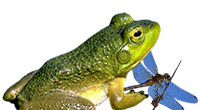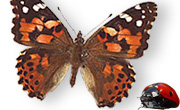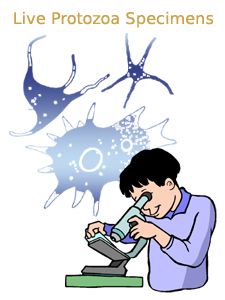Fax: (916) 381-4006



Live Protozoa Specimens |
 Protozoa (in Greek proto = first and zoa = animal) are single-celled eukaryotes (organisms whose cells have nuclei) that show some characteristics usually associated with animals, most notably mobility and heterotrophy. Protozoa (in Greek proto = first and zoa = animal) are single-celled eukaryotes (organisms whose cells have nuclei) that show some characteristics usually associated with animals, most notably mobility and heterotrophy.
They are often grouped in the kingdom Protista together with the plant-like algae and fungus-like water molds and slime molds. In some newer schemes, however, most algae are classified in the kingdoms Plantae and Chromista, and in such cases the remaining forms may be classified as a kingdom Protozoa. The name is misleading, since they are not animals. Protozoa have traditionally been divided on the basis of locomotion, although this is no longer believed to represent genuine relationships:
Most protozoans are too small to be seen with the naked eye - most are around 0.01-0.05 mm, although forms up to 0.5 mm are still fairly common - but can easily be found under a microscope. Protozoa are ubiquitous throughout aqueous environments and the soil, and play an important role in their ecology. Protozoa occupy a range of trophic levels. As predators upon unicellular or filamentous algae, bacteria, and microfungi, protozoa play a role both as herbivores and as consumers in the decomposer link of the food chain. Protozoa also play a vital role in controlling bacteria population and biomass. As components of the micro- and meiofauna, protozoa are an important food source for microinvertebrates. Thus, the ecological role of protozoa in the transfer of bacterial and algal production to successive trophic levels is important. Protozoa are also important as parasites and symbionts of multicellular animals.
|
| Featured Items |
|---|
| Amoeba Proteus - Class 12... |
 The Amoeba proteus is an amoeba closely related to the giant amoebae. It belongs to the Rhizopoda, more specif...
The Amoeba proteus is an amoeba closely related to the giant amoebae. It belongs to the Rhizopoda, more specif... |
|
Read more »»»
$32.80 (Buy Now) |
|---|
| Blepharisma - Class 120 |
 Blepharisma is a genus of heterotrich ciliates (a type of protista) which contains many species. Its members a...
Blepharisma is a genus of heterotrich ciliates (a type of protista) which contains many species. Its members a... |
|
Read more »»»
$32.80 (Buy Now) |
|---|
| Euglena - Class 120 |

Euglena is a genus of microscopic, one-celled organisms in the Protista kingdom. There are about 150 ... |
|
Read more »»»
$32.80 (Buy Now) |
|---|
| Paramecium Caudatum - Cla... |
 Paramecia abound in freshwater ponds throughout the world; one species lives in marine waters. They are easily...
Paramecia abound in freshwater ponds throughout the world; one species lives in marine waters. They are easily... |
|
Read more »»»
$32.80 (Buy Now) |
|---|
| Stentor - Class 120 |
 The trumpet animalcule Stentor is one of the largest unicellular organisms. Most of the time it lives attached...
The trumpet animalcule Stentor is one of the largest unicellular organisms. Most of the time it lives attached... |
|
Read more »»»
$32.80 (Buy Now) |
|---|
9298 Elder Creek Road
Sacramento, CA 95829
(916) 386-2665
9298 Elder Creek Road
Sacramento, CA 95829
(916) 386-2665